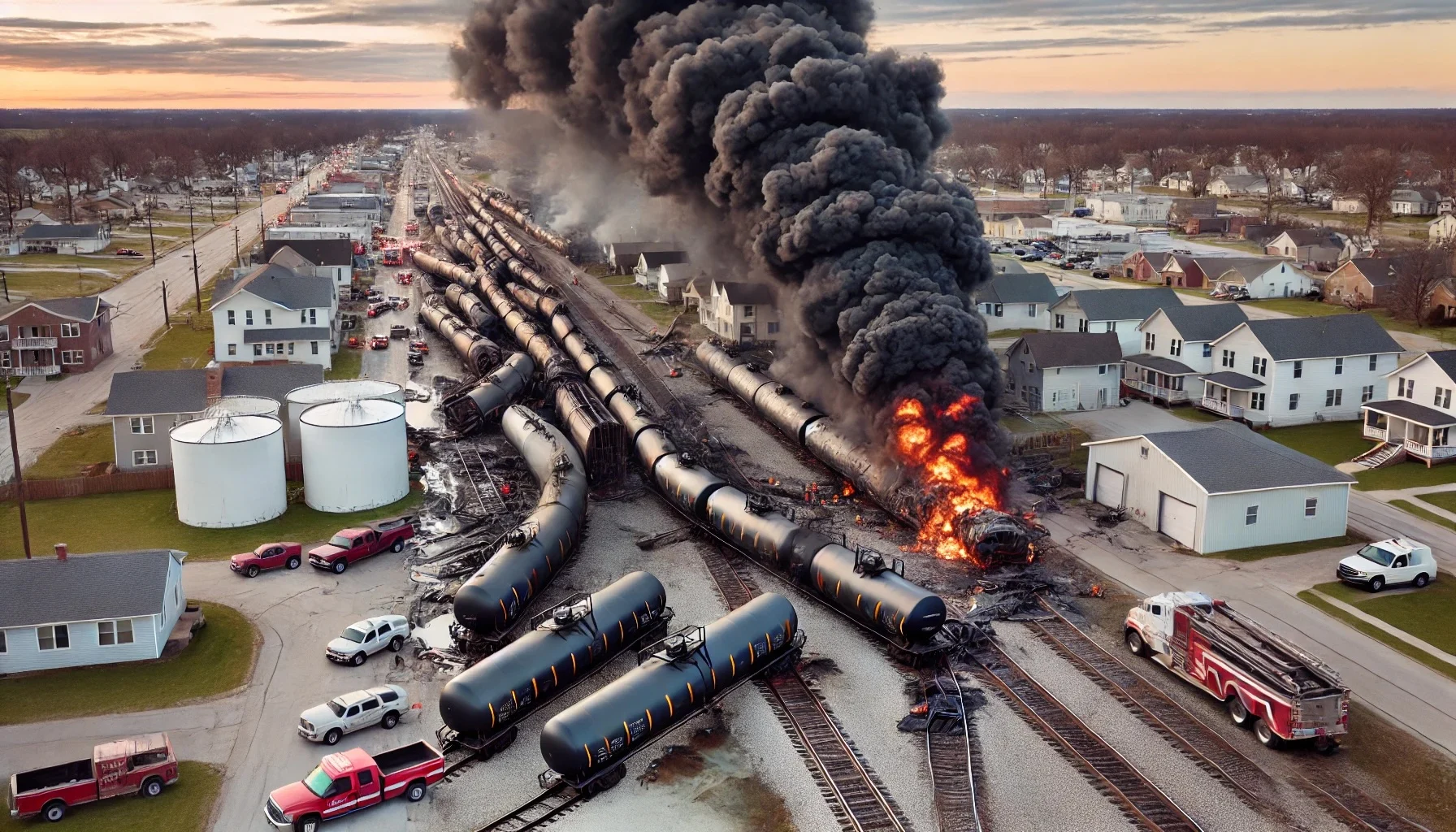
The Lac-Mégantic Rail Disaster
by: The Calamity Calendar Team
July 6, 2013
Prelude to Disaster
Lac-Mégantic, a picturesque town in Quebec, Canada, nestled quietly as evening fell on July 5, 2013. However, the calm was deceptive. At about 11:00 PM, engineer Thomas Harding parked a freight train operated by the Montreal, Maine & Atlantic Railway (MMA) on a descending grade in the nearby town of Nantes. The train, consisting of 72 tank cars, 63 of which carried highly flammable crude oil, was left unattended.
The MMA railway company was notorious for its cost-cutting measures, which included operating with a single engineer and utilizing aging, less reliable tank cars. Harding secured the train using a combination of air brakes and a few hand brakes before leaving it for the night. This would soon prove to be a grave misjudgment.
Ignition and Runaway
Shortly before midnight, at around 11:45 PM, an engine fire broke out in the lead locomotive. The Nantes Fire Department responded promptly, extinguishing the blaze and shutting down the locomotive’s power. Unbeknownst to the firefighters, this action resulted in the gradual release of the train’s air brakes, leaving only the insufficiently set hand brakes to hold the heavy train on the grade.
By 12:56 AM on July 6, the train began to move. Slowly at first, but as it descended the incline, it gained unstoppable momentum, careening toward the heart of Lac-Mégantic, just 11 kilometers away.
Thanks for subscribing!
The Impact
At 1:14 AM, disaster struck. The runaway train derailed at high speed in downtown Lac-Mégantic. Several tank cars exploded almost immediately upon impact, creating a massive fireball that lit up the night sky. The resulting inferno spread rapidly, consuming everything in its path.
One of the hardest-hit places was the Musi-Café, a popular bar filled with patrons enjoying a summer night out. The explosion and subsequent fires destroyed 40 buildings, turning the downtown area into a smoldering wasteland. Oil spilled into the nearby Chaudière River, causing extensive environmental damage.
Aftermath and Devastation
The Lac-Mégantic rail disaster was a human and environmental catastrophe. Forty-seven people lost their lives, and many more were injured. The devastation extended beyond human loss; the economic impact was profound as the heart of the town was obliterated. The community faced a monumental task of rebuilding, both physically and emotionally.
Response and Investigation
Emergency services from both Canada and the United States rushed to the scene, battling the blaze and searching for survivors. The scope of the destruction was overwhelming, and the fire raged for days before being fully extinguished.
The Transportation Safety Board of Canada (TSB) launched an investigation, revealing critical failures in safety procedures and regulatory oversight. The TSB report highlighted inadequate hand brakes and the railway’s reliance on a single operator as key factors leading to the disaster. The incident also underscored the broader risks of transporting crude oil by rail.
Legal and Regulatory Repercussions
The disaster prompted a wave of legal actions. Various lawsuits were filed against MMA and other parties involved. Criminal charges were brought against three MMA employees, including Thomas Harding, but they were acquitted in 2018.
In the wake of the disaster, both Canadian and American authorities implemented stricter rail safety regulations. Canada introduced new rules for hand brakes, tank car standards, and protocols for transporting hazardous materials. The United States’ Federal Railroad Administration (FRA) and the Pipeline and Hazardous Materials Safety Administration (PHMSA) also tightened their regulations, aiming to prevent a repeat of such a tragedy.
Rebuilding and Healing
The town of Lac-Mégantic embarked on a long and arduous journey of recovery. Rebuilding the downtown area required significant investment and time. Environmental cleanup efforts were extensive, addressing the contamination of the Chaudière River and surrounding areas.
Despite the progress, the emotional scars from that night remain. The community continues to honor the memory of the victims through memorials and annual commemorations. The disaster’s legacy serves as a stark reminder of the importance of rigorous safety standards in the transportation of hazardous materials.
Conclusion
The Lac-Mégantic rail disaster was a night of unimaginable horror, transforming a quiet town into a scene of devastation. It exposed severe deficiencies in rail safety practices, prompting vital regulatory changes that continue to shape the industry today. The resilience and determination of Lac-Mégantic’s residents to rebuild and remember those lost stand as a testament to the human spirit in the face of tragedy.
Stay in the Loop!
Become a Calamity Insider and get exclusive Calamity Calendar updates delivered straight to your inbox.
Thanks! You're now subscribed.